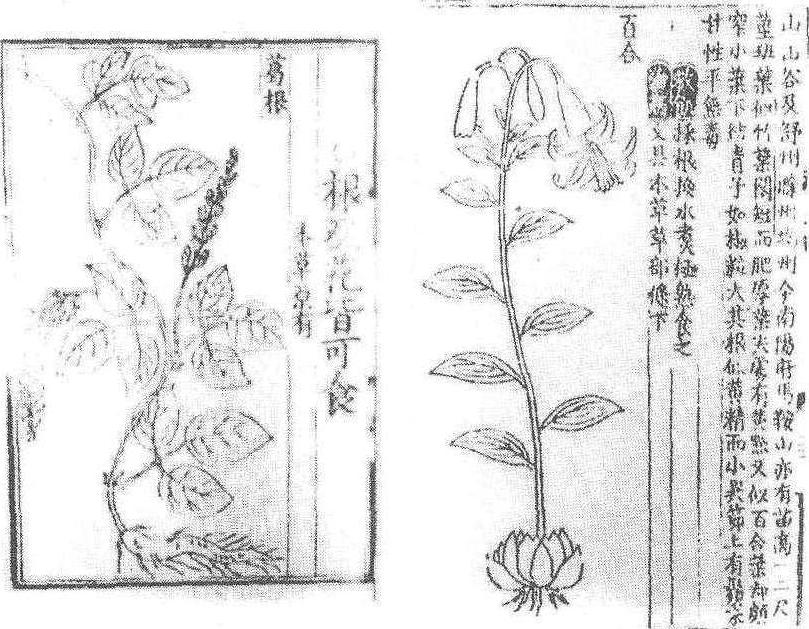救荒本草
本草类著作。明朱(?—1425)等撰。四卷。有《普济方》已著录。约成书于明永乐四年(1406)。书中广采民间草木可食者四百余种(包括根、茎、叶、花、实)进行培植,详细观察,绘制成图,附加文字说明。简述别名、产地、植物形态、性味、有毒无毒、食用部位及方法。以备荒馑时期,代食之用。书中虽未能详述药物主治,但对某些野生草药,形态、产地的记述颇为详明,对本草学的发展有所贡献。此书另有二卷本及十四卷本。有明万历十四年(1586)刊本,清道光十七年(1837)任树森序刊《农政全书》本及一九二九年商务印书馆铅印《万有文库》本。
107 救荒本草
明朱元璋第5子朱棣撰。初刊于1406年。全书分为5部,有草部245种,木部80种,米谷部20种,果部23种,药部46种,共414种。作者在自己的园圃里栽植,亲自观察,由画工依照实物逐一绘图,附以说明,指出产地、形态、性味及其可食部分和食用方法等。书中图说,为《植物名实图考》转载达209种之多。
《救荒本草》Edible Herbes and OtherPlants Needed in Disaster Relief
中国历史上最早的一部以救荒为宗旨的农学、植物学专著。撰者朱橚(?~1425),明太祖朱元璋第五子,封周王,谥“定”,故又题周定王撰。朱橚“好学能词赋,以国土夷旷,庶草蕃庑”。他搜集草木种苗400余种,栽培于园圃,亲自观察记录、鉴别性味、访问民间,凡可以充饥者,命画工按植物实际生长情况绘出图谱(见图)。全

《救荒本草》所载植物图
书共收载植物414种,其中已见之于历代本草者138种,作者新增276种,恰为全书的2/3。分为草(245种)、木·(80种)、米谷(20种)、果(23种)、菜(46种)五部。各部皆按叶、根、实、笋、花、茎等可食部分分类叙述。该书比较准确地记载了植物的名称、别名、产地、环境、分布以及形态特征、性味。从植物学的角度来看,该书对形态特征的描述、花器官在分类上的作用以及学术用语的丰富等方面,都明显地超过了历代本草的水平。此书是为抗灾荒、救饥民而作,故撰著时为难认的生僻字注音,运用形象的比喻、同类植物互相比拟的手法,再配以写真的图画,通俗易懂。全书以正确地辨认和安全地食用植物为中心组成框架结构,指导民众采摘果、叶,剥取树皮,挖掘根、茎,以及如何加工食用。救饥的食用方法有生食或鲜食、腌制和干藏,以及漂洗和长时间蒸煮等去毒方法。除救荒食用外,书中还记载了植物的综合利用方法,实用性很强。在它的影响下,明清两代先后有10部救荒著作问世,如王西楼《野菜谱》、周履清《茹草编》、鲍山《野菜博录》等。该书的内容也被大量摘引。
《救荒本草》原书两卷,永乐四年(1406)由作者刊行于开封,现已亡佚。嘉靖四年(1525)山西太原第二次刊刻,即今流行最古刻本,传刻时分为四卷。嘉靖三十四年开封人陆柬又根据第二次刻本重刻,然误认为此书为周宪王即朱橚之子朱有燉所著。国内现有版本十五六种,日本享保三年(1716)和宽正十一年(1799)两次重刻。美国植物学家李德(A. S. Lead)在《植物学简史》(1942年)中赞誉《救荒本草》绘图精细,超过当时的欧洲水平。英国药物学家伊博恩(Bernard E.Read)将该书译成英文,并对其植物成分作了分析。本世纪40年代日本出版的食用植物书籍仍在引用该书。1959年中华书局据嘉靖四年刻本影印出版。
救荒本草
中国古代介绍可供荒年食用的野生植物的一部专著。明代开国皇帝朱元璋第五子朱所撰。明永乐四年 (1406年) 刊刻。书中记载了四百一十四种可食野生植物。均系作者亲自搜集,亲自种植、观察,并请画工逐一绘图,附加说明,指出产地、形态、性味及其可食部分和食法。这些野生植物可在渡荒济急时食用,有的也可供常年食用。明末徐光启将该书全部内容收入其撰著的《农政全书》的“荒政”部分。明末鲍山撰写的 《野菜博录》,也多取材于此书。
救荒本草
农书。明朱橚(生平参见《普济方》条)编。《明史》本传称其“好学能词赋。以国土夷旷,庶草蕃庑,考核其可佐饥馑者得四百余种,绘图疏之”。永乐四年(1406),朱橚即去开封刻印《救荒本草》,用以在饥馑之年指导灾民度荒。此外,他还采取古今方剂,汇编成《普济方》一百六十八卷。
《救荒本草》共收草部二百四十五种,木部八十种,米谷部二十种,果部二十三种,菜部四十六种,其中出《本草》者一百三十八种,新增二百七十六种,总计达四百一十四种。每部均标明可食部分,各种植物除配以插图外,还分“救饥”与“治病”两部分介绍。《〈救荒本草〉序》谓,周王“体仁遵义,孳孳为善,凡可以济人利物之事,无不留意。尝读孟子书,至于五谷不熟,不如荑稗。因念林林总总之民,不幸罹于旱涝,五谷不熟,则可以疗饥者,不止荑稗而已”。其时,开封当地野生植物种类颇多,朱橚亲自观察研究,记录每种可食的部分,并根据其形态绘图,详述其功用,以备荒年疗饥之用。《救荒本草》在我国农史上占有重要地位,堪称十五世纪初中国植物学家调查研究工作的科学记录。其“遇荒岁,按图而求之,随地皆有,无艰得者,苟如法采食,可以活命”,“有功于生民大矣”(李濂《重刻〈救荒本草〉序》),故此书一刻再刻,同时代的大科学家徐光启曾将它全部收入其《农政全书》之荒政部分(作者署周宪王),足见其对救灾的重要作用。
有明永乐四年(1406)开封刻本和嘉靖四年(1525)山西刻本。
救荒本草
(明)朱撰。4卷。录可食草木414种,分5类:草类245种,木类80种,米谷类20种,果类23种,菜类46种。每种详记产地、形态、性味、食用方法。有中华书局1959年影印本。
《救荒本草》Edible Wild Herbs Against Disasters
明代救荒名著。 朱撰。 为明太祖朱元璋第五子,封周王,死后谥“定”,《明史·艺文志》将本书题为“周定王撰”。 封在开封,当地野生植物种类很多,他搜集很多野生植物种在园内,并亲自观察研究,把每种植物可食部分记下,将荒年可充饥的一一绘成图,并加说明著成本书。初刻于永乐四年(1406)。全书四卷,分为5部,计有草部245种、木部80种、米谷部20种、果部23种、菜部46种,共414种。除过去见于本草书者,新增276种。荒政是中国传统农业的组成部分,故将此书视为农书著录。
救荒本草
二卷。明朱(? ——1425)撰。朱, 明太祖朱元璋第五子, 洪武三年 (1370年) 被封为吴王,洪武十一年 (1378年) 改封周王,洪武十四年(1381年)就藩开封。洪武二十二年(1389年),朱因擅离藩国遭废, 永乐初年复爵。 洪熙元年 (1425年),朱死去,谥号“定”。朱平生刻苦好学,能词赋,曾创作《元宫词》百章,又“以国土夷旷,庶草蕃庑,考核其可佐馑者四百余种,绘图疏之,名《救荒本草》。”《救荒本草》不但记录了400余种野菜、果木的名称,准确绘制了图画,而且分别详细介绍了各种野菜、果木的产地、颜色、形状、味道、习性及烹食方法等等。《救荒本草》的出现,对于随时都可遭到自然灾害袭击的平民百姓来说,无疑是一种福音。李时珍《本草纲目》认为《救荒本草》为周宪王朱有燉所撰,嘉靖乙卯年(1555年)陆东重刊《救荒本草》,也认为是周宪王朱有燉所撰,此恐为辗转传讹所致,朱所撰,已成公认。清代《救荒本草》被列入《四库全书·子部农家类》。
《救荒本草》
中国明代食用野生植物农书。作者朱棣。永乐4年(1406)完成初刻。全书4卷,分为5部:草部245种,木部80种,米谷部20种、果部23种,菜部46种,共记载植物414种(附实物图)。其中276种为以往本草书中所没有的。